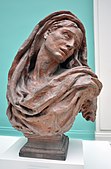
Bust (sculpture)

A bust is a sculpted or cast representation of the upper part of the human figure, depicting a person's head and neck, and a variable portion of the chest and shoulders. The piece is normally supported by a plinth. The bust is generally a portrait intended to record the appearance of an individual, but may sometimes represent a type. They may be of any medium used for sculpture, such as marble, bronze, terracotta, plaster, wax or wood.
As a format that allows the most distinctive characteristics of an individual to be depicted with much less work, and therefore expense, and occupying far less space than a full-length statue, the bust has been since ancient times a popular style of life-size portrait sculpture. It can also be executed in weaker materials, such as terracotta.
A sculpture that only includes the head, perhaps with the neck, is more strictly called a "head", but this distinction is not always observed. Display often involves an integral or separate display stand. The Adiyogi Shiva statue located in India representative of Hindu God Shiva is the world's largest bust sculpture and is 112 feet (34 m) tall.
History
Antiquity
Sculptural portrait heads from classical antiquity, stopping at the neck, are sometimes displayed as busts. However, these are often fragments from full-body statues, or were created to be inserted into an existing body, a common Roman practice; these portrait heads are not included in this article. Equally, sculpted heads stopping at the neck are sometimes mistakenly called busts.
The portrait bust was a Hellenistic Greek invention (although the Egyptian bust presented below precedes Hellenic productions by five centuries), though very few original Greek examples survive, as opposed to many Roman copies of them. There are four Roman copies as busts of Pericles with the Corinthian helmet, but the Greek original was a full-length bronze statue. They were very popular in Roman portraiture.
The Roman tradition may have originated in the tradition of Roman patrician families keeping wax masks, perhaps death masks, of dead members, in the atrium of the family house. When another family member died, these were worn by people chosen for the appropriate build in procession at the funeral, in front of the propped-up body of the deceased, as an "astonished" Polybius reported, from his long stay in Rome beginning in 167 BC. Later these seem to have been replaced or supplemented by sculptures. Possession of such imagines maiorum ("portraits of the ancestors") was a requirement for belonging to the Equestrian order.
Middle Ages
Some reliquaries were formed as busts, notably the famous Bust of Charlemagne in gold, still in the Aachen Cathedral treasury, from c. 1350. Otherwise it was a rare format.
Renaissance
Busts began to be revived in a variety of materials, including painted terracotta or wood, and marble. Initially most were flat-bottomed, stopping slightly below the shoulders. Francesco Laurana, born in Dalmatia, but who worked in Italy and France, specialized in marble busts, mostly of women.
Baroque
The round-bottomed Roman style, including, or designed to be placed on, a socle (a short plinth or pedestal), became most common. Gian Lorenzo Bernini, based in Rome, did portrait busts of popes, cardinals, and foreign monarchs such as Louis XIV. His Bust of King Charles I of England (1638) is now lost; artist and subject never met, and Bernini worked from the triple portrait painted by Van Dyck, which was sent to Rome. Nearly 30 years later, his Bust of the young Louis XIV was hugely influential on French sculptors. Bernini's rival Alessandro Algardi was another leading sculptor in Rome.
Pictorial timeline
Bust of Nefertiti by Thutmose (limestone, c. 1345 BC)
Lady of Elche (limestone, Iberian, 4th century BC)
Pericles with the Corinthian helmet (marble, Roman after a Greek original, c. 430 BC)
Bronze bust of Lucius Junius Brutus, the Capitoline Brutus (late 4th century BC to early 3rd century BC)
The Empress Vibia Sabina (c. 130 AD)
Roman bust (c. 193-203, in the Venice National Archaeological Museum)
Bust of Jayavarman VII (c. 1181-1218, in the Guimet Museum)
Reliquary bust of Charlemagne (gold, Aachen Cathedral treasury, c. 1350)
Francesco Laurana, A Princess of the House of Aragon, c. 1475
Giuliano de' Medici by Andrea del Verrocchio (terracotta, 1475–85)
Terracotta bust of Henry VII of England by Pietro Torrigiano
Jakob Fugger the Rich by Conrat Meit (polychrome wood, c. 1515)
Charles V, King of Spain and Holy Roman Emperor, by Leone and Pompeo Leoni (bronze, 1553, Museo del Prado)
Terracotta modello by Alessandro Algardi of Cardinal Paolo Emilio Zacchia, c. 1650
Ramchandra Pant Amatya, the Finance Minister of the Maratha Empire. (1674–1689)
Jules Hardouin-Mansart by Jean-Louis Lemoyne (marble, 1703)
Bust of a Man from the studio of Francis Harwood (black limestone, c. 1758)
King George III (1767 CE)
Simplicity of the Highest Degree, ninth in a series of character heads by Franz Xaver Messerschmidt (alabaster, after 1770)
Étienne Vincent-Marniola by Joseph Chinard (terracotta, 1809)
Bust of Emperor Pedro I of Brazil by Marc Ferrez (bronze, 1826)
Chief Beshekee by Francis Vincenti (marble, 1855–56)
The Veiled Nun (marble, c. 1863)
Mater Dolorosa by Jean-Baptiste Carpeaux (terracotta, 1869–70)
Tsar Alexander II by Ivan Fedorovitch Kovchenkov (malachite (the stand) and bronze, 1873)
J. V. Snellman by Johannes Takanen at the Snellman Park in Kuopio (1886)
Viktor Nessler by Alfred Marzolff (bronze, 1890s)
Jeanne Granier by Francis de Saint-Vidal (late 19th century)
Faduma Ali, wife of Prince Luigi Amedeo, Duke of the Abruzzi (Italian Somaliland, c. 1920s)
Keys To Community (featuring Benjamin Franklin) by James Peniston (2007)
See also
- Belting, Hans, An Anthropology of Images: Picture, Medium, Body, 2014, Princeton University Press, ISBN 0691160961, 9780691160962, google books
- Stewart, Peter, Statues in Roman Society: Representation and Response, 2003, Oxford University Press, ISBN 0199240949, 9780199240944, google books
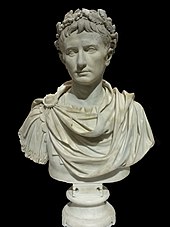



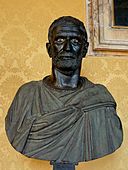

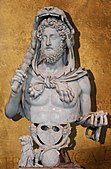



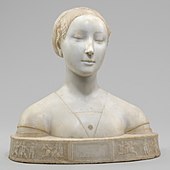








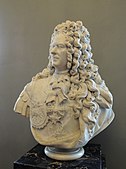
![Bust of a Man[5] from the studio of Francis Harwood (black limestone, c. 1758)](http://upload.wikimedia.org/wikipedia/commons/thumb/d/d9/Bust_of_a_Man_by_the_studio_of_Francis_Harwood.jpg/127px-Bust_of_a_Man_by_the_studio_of_Francis_Harwood.jpg)






